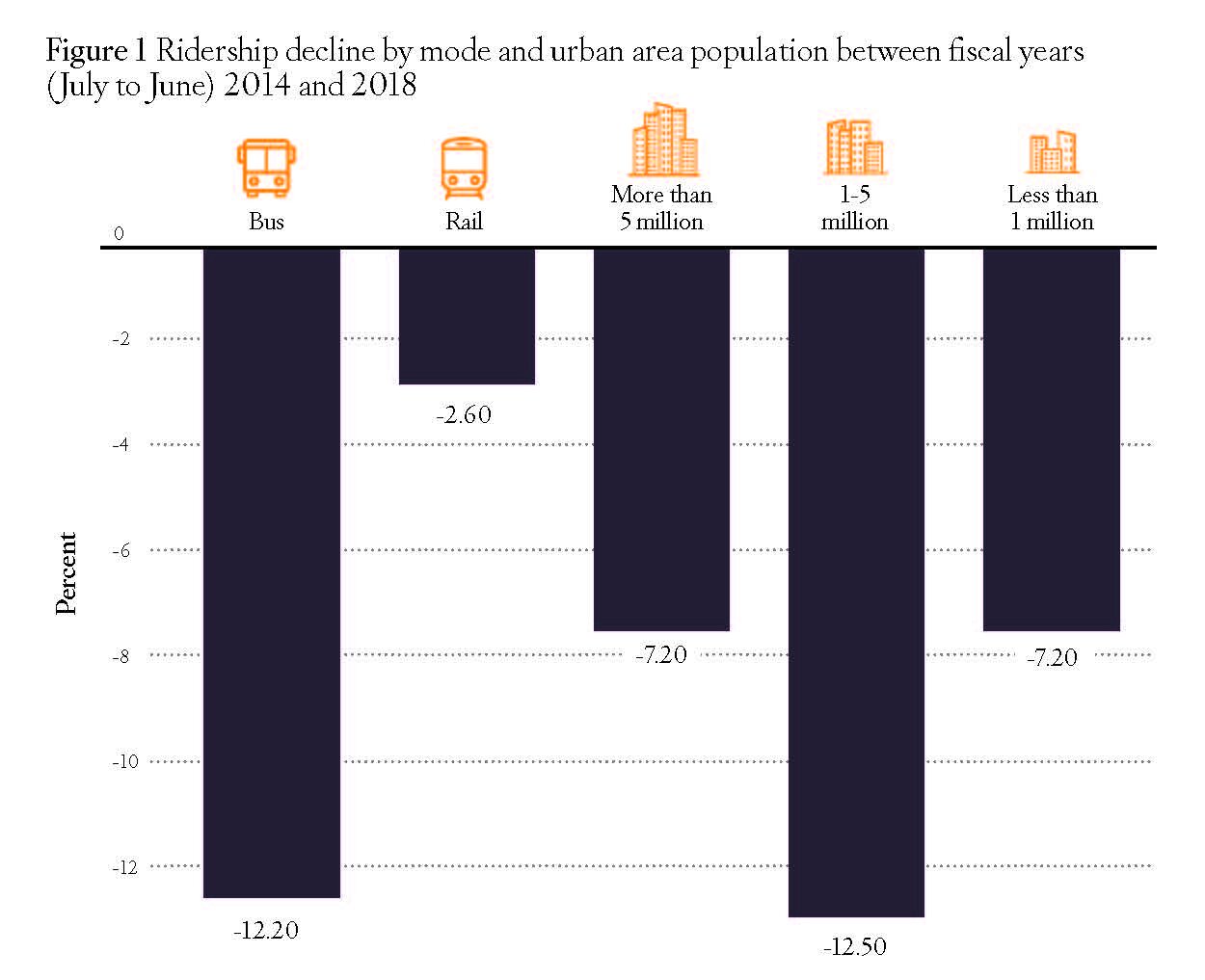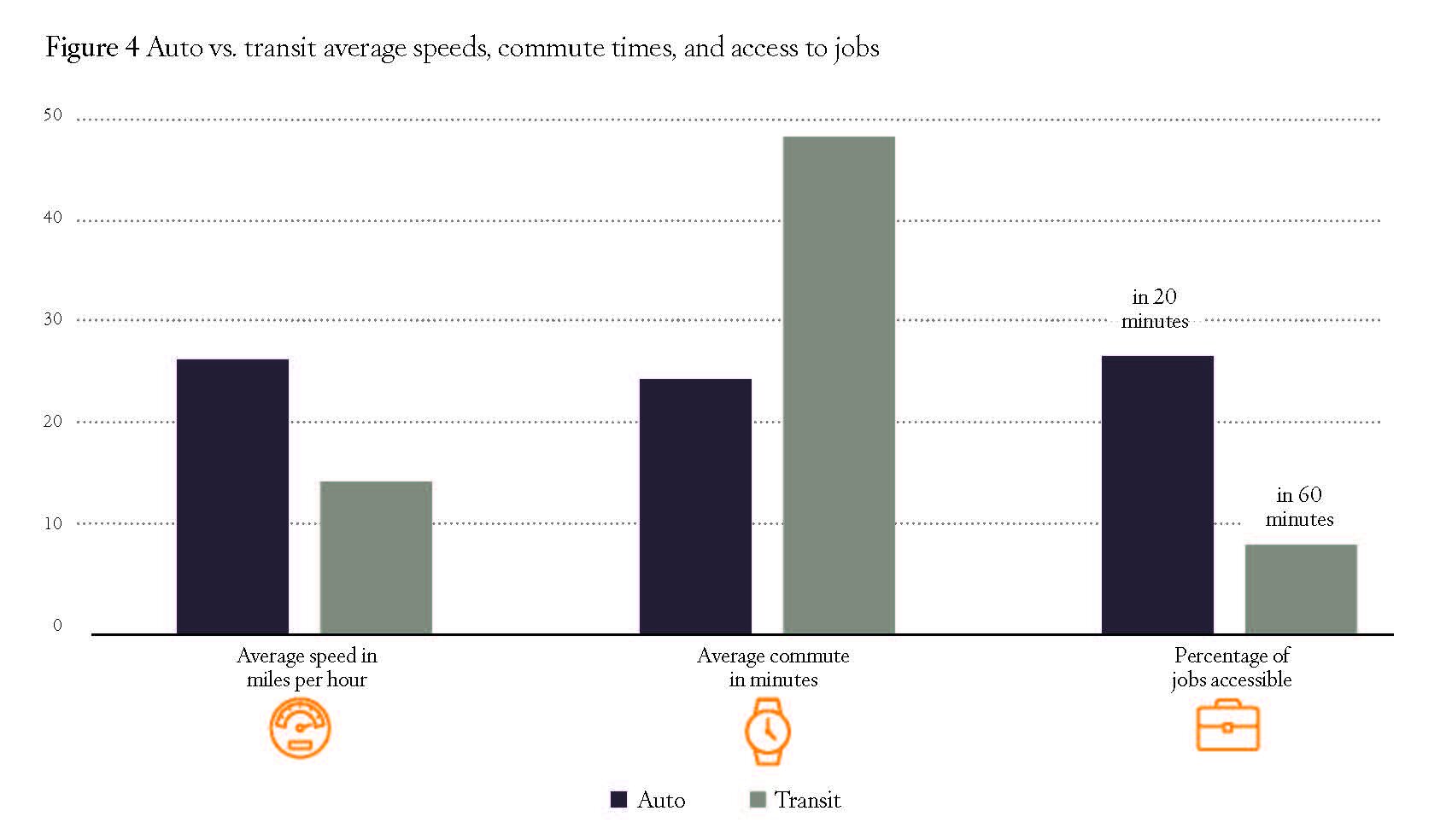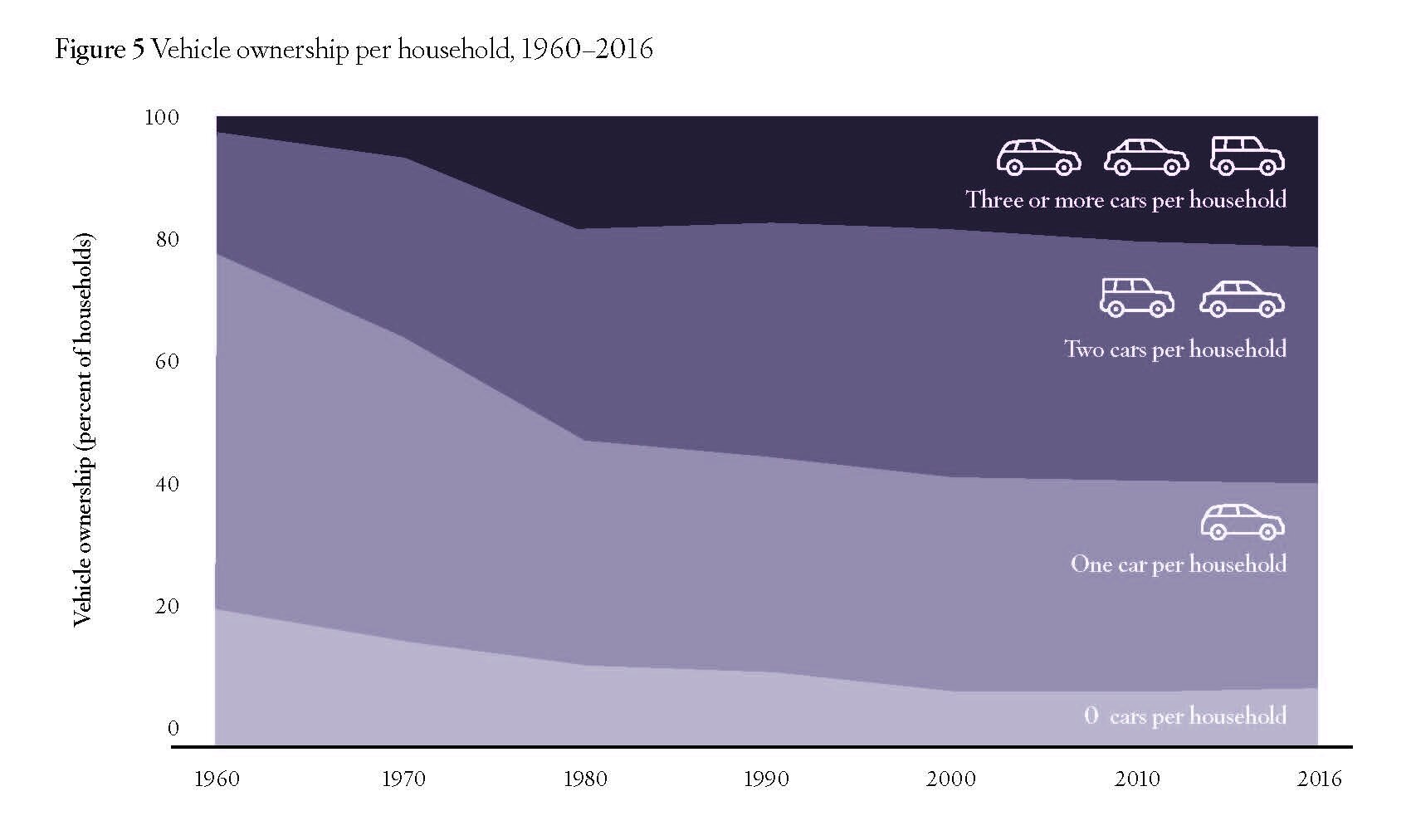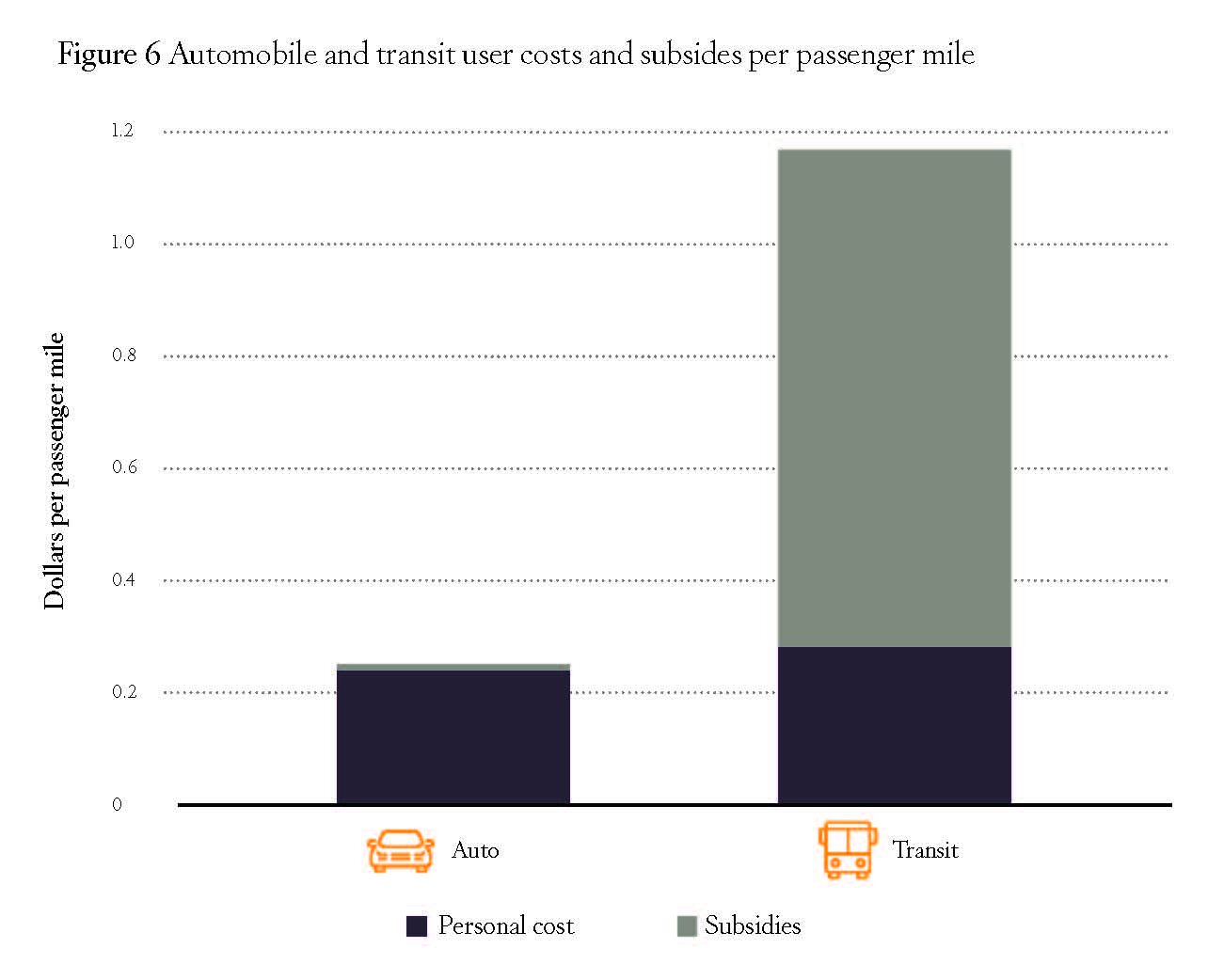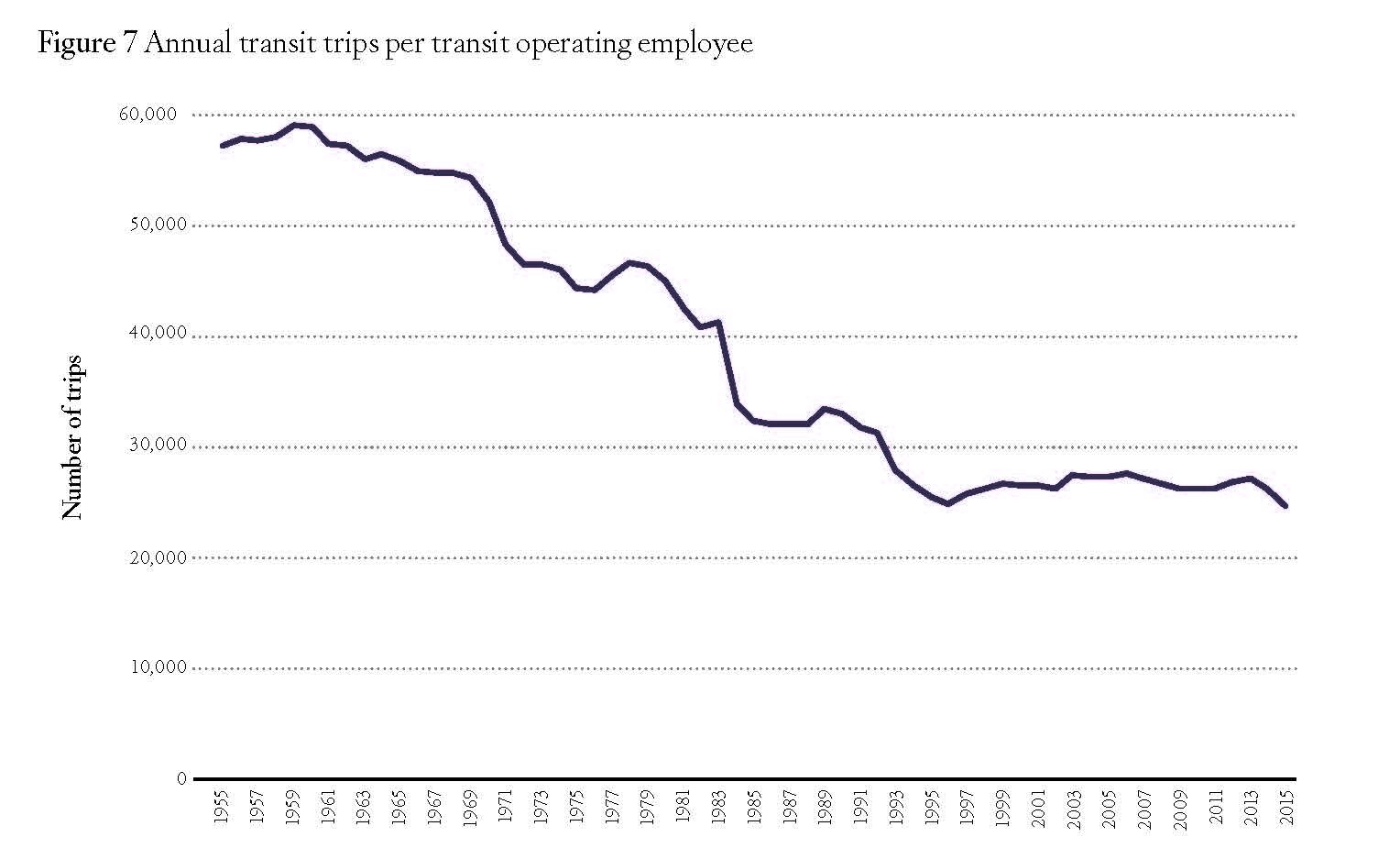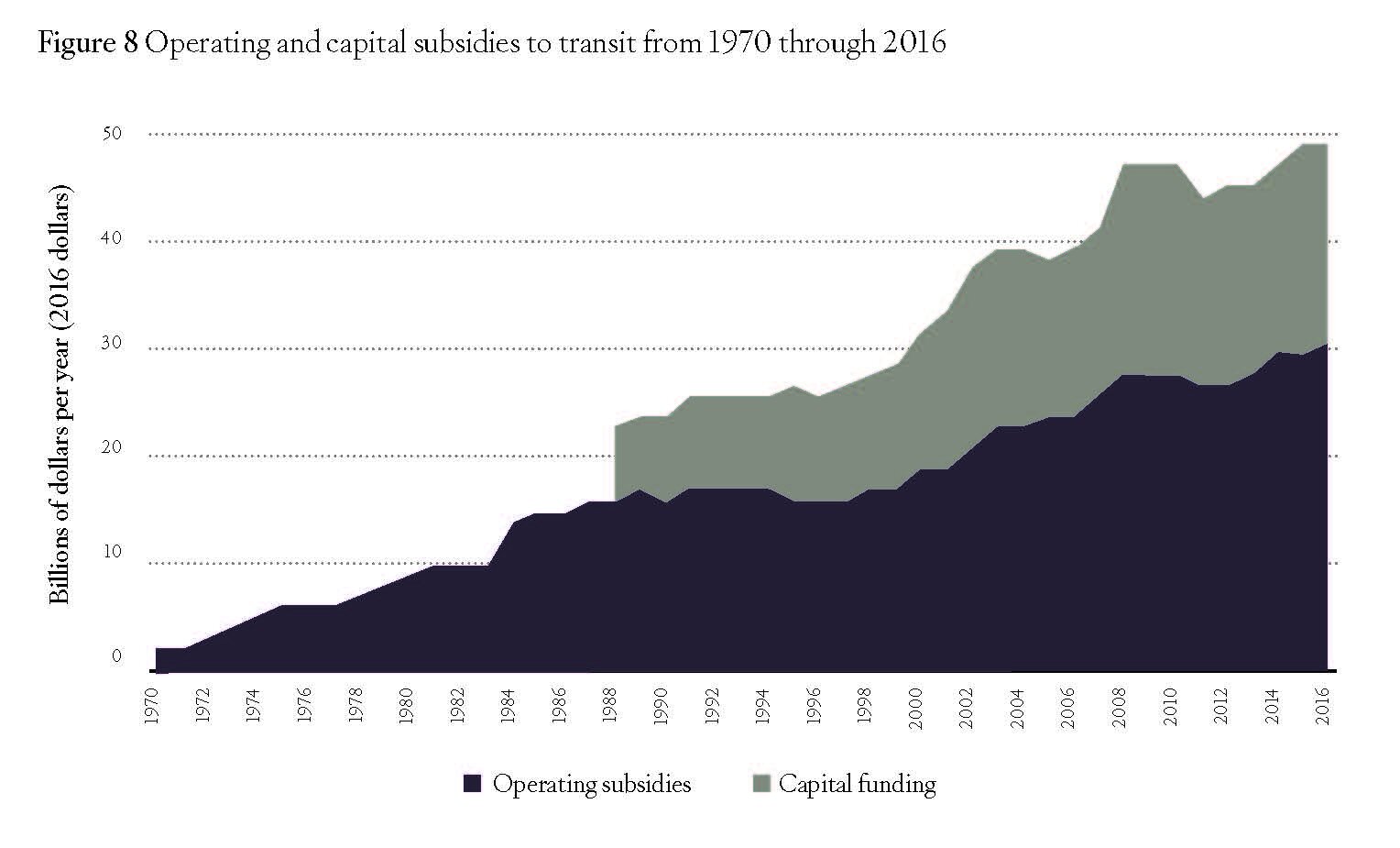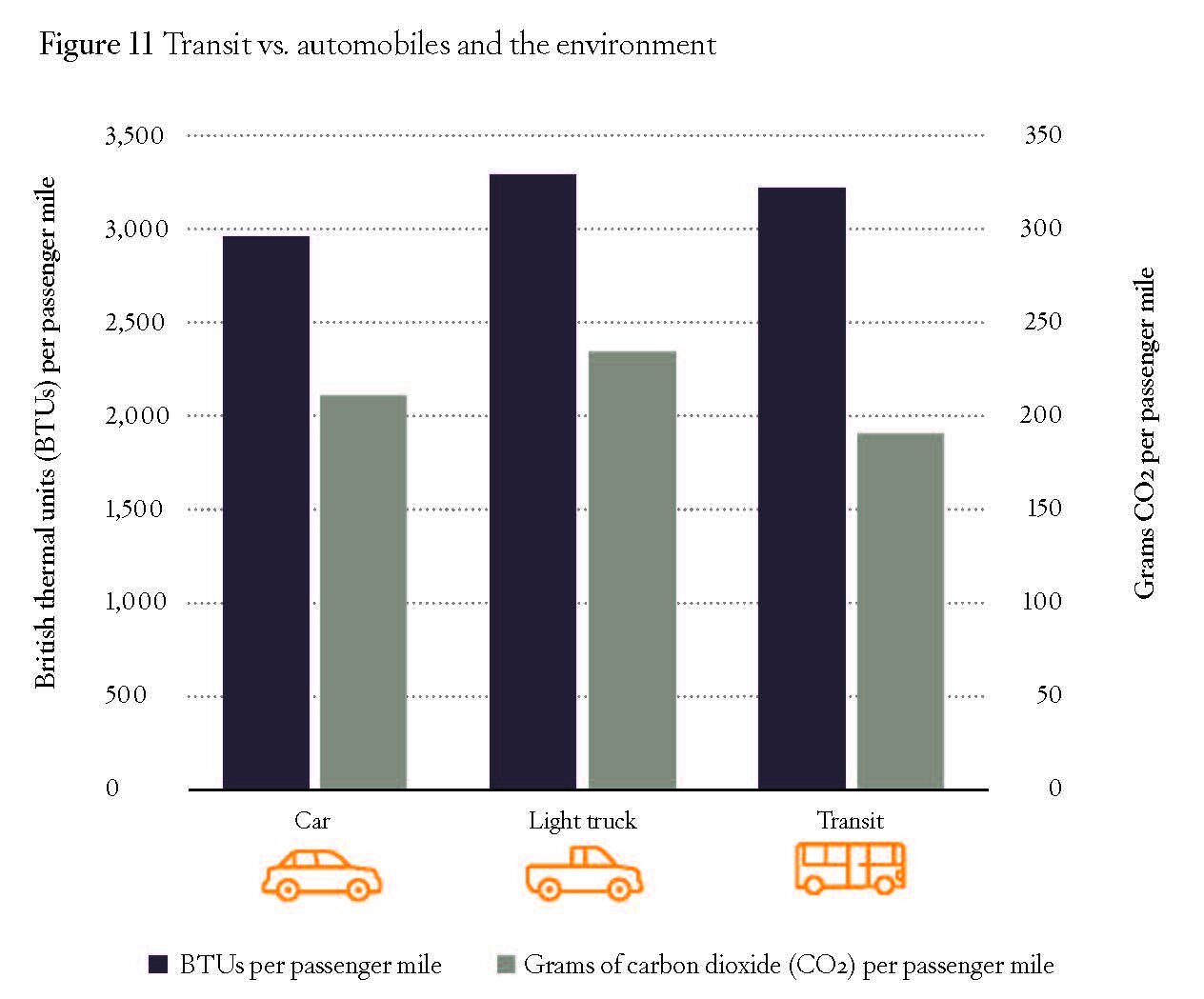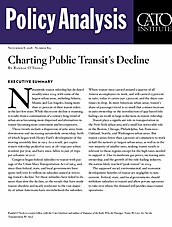Nationwide transit ridership has declined steadily since 2014, with some of the largest urban areas, including Atlanta, Miami, and Los Angeles, losing more than 20 percent of their transit riders in the last few years. While this recent decline is stunning, it results from a continuation of a century-long trend of urban areas becoming more dispersed and alternatives to transit becoming more convenient and less expensive.
Those trends include a dispersion of jobs away from downtowns and increasing automobile ownership, both of which began with Henry Ford’s development of the moving assembly line in 1913. As a result, per capita transit ridership peaked in 1920 at 287 trips per urban resident per year, and have since fallen to just 38 trips per urbanite in 2017.
Congress began federal subsidies to transit with passage of the Urban Mass Transportation Act of 1964, and since then federal, state, and local governments have spent well over $1 trillion on subsidies aimed at reversing transit’s decline. Yet those subsidies have failed to do more than slow the decline, as the trends that have made transit obsolete and nearly irrelevant to the vast majority of urban Americans have overwhelmed the subsidies. Where transit once carried around a quarter of all American employees to work, and still carried 13 percent in 1960, today it carries just 5 percent, and the share continues to drop. In most American urban areas, transit’s share of passenger travel is so small that a minor increase in auto ownership or the introduction of app-based ride hailing can result in large reductions in transit ridership.
Transit plays a significant role in transportation in the New York urban area and a small but noticeable role in the Boston, Chicago, Philadelphia, San Francisco–Oakland, Seattle, and Washington urban areas. But transit carries fewer than 3 percent of commuters to work in half the nation’s 50 largest urban areas, as well as in the vast majority of smaller ones, making transit nearly irrelevant to those regions except for the high taxes needed to support it. Due to moderate gas prices, increasing auto ownership, and the growth of the ride-hailing industry, the nation likely reached “peak transit” in 2014.
The supposed social, environmental, and economic development benefits of transit are negligible to nonexistent. Federal, state, and local governments should withdraw subsidies to transit and allow private operators to take over where the demand still justifies mass transit operations.
Introduction
The federal, state, and local governments spend more than $50 billion a year subsidizing public transit, yet transit ridership has declined in each of the last four years. The reasons for the subsidies are also declining, as the social, environmental, and economic benefits that transit supposedly provides are either fading away or were exaggerated in the first place. In a series of twelve charts, this paper explains the decline in ridership and its implications for the future.
Transit Ridership Is Declining
Nationwide transit ridership in the fiscal year ending in June 2018 was 2.7 percent less than in the year ending in June 2017 (the fiscal year for most transit agencies is from July 1 to June 30). This follows three years of steady losses in FY14 through FY17, resulting in a 7.5 percent total decline between FY14 and FY18 (Figure 1).1 Ridership is falling in big cities and small cities, in cities with decrepit transit infrastructure and cities with brand-new infrastructure, and it is falling for both rail and bus. The following charts should help clarify the past, present, and future of transit in the United States.
The 2008 financial crisis led nationwide transit ridership to fall through 2010, but it then recovered along with the economy for a few years. Since 2014, however, ridership has been steadily falling in almost every urban area despite a strengthening economy. Figure 1 shows that ridership is declining whether it is bus or rail and whether it is in large, medium, or small urban areas.2
Source: National Transit Database, “Monthly Module Adjusted Data Release,” Federal Transit Administration, June 2018, tinyurl.com/yatym9t7.No type of urban area is immune: the legacy rail regions with big downtowns — New York, Chicago, Philadelphia, Washington, Boston, and San Francisco–Oakland — saw ridership fall by 5.4 percent. The 24 urban areas that have introduced commuter, light, or heavy rail since 1975, ranging from Los Angeles to Buffalo, have seen ridership fall by 11.2 percent. The 18 largest urban areas that lack rail transit (or have no more than a tiny streetcar line) have seen bus ridership decline by 9.3 percent.3
Transit’s Recent Decline Is Nearly Catastrophic in Some Urban Areas
A 7.5 percent drop in ridership between 2014 and 2018 may not sound catastrophic, but some urban areas have seen much larger declines. Transit agencies spent $46.9 billion on operations in 2016 and paid for about a third of those operating costs, or $15.8 billion, out of fare revenues.4 For budgeting purposes, agencies normally expect fares revenues to stay constant or increase, so large drops in ridership from their most recent peak can produce serious financial problems. If fares cover a third of operating costs, then a 30 percent decline means a 10 percent reduction in operating funds, which in turn forces agencies to either curtail existing transit service or raise fares, both of which will further reduce ridership.
Figure 2 shows that transit ridership in 31 of the nation’s 50 largest urban areas has dropped 15 percent or more since the year of highest ridership in each region in the last decade. Eleven of those regions have lost 30 to 47 percent of their riders.5 The worst was Memphis, and a recent report prepared by noted transit expert Jarrett Walker for the city of Memphis observed, “Memphis is experiencing a slow-moving self-reinforcing decline in transit, which could be called a vicious cycle of declining ridership and service.”6
Source: National Transit Database, “Monthly Module Adjusted Data Release,” Federal Transit Administration, June 2018, tinyurl.com/yatym9t7.“I call it the transit death spiral,” says Darrell Johnson, the CEO at California’s Orange County Transportation Authority. “It’s a never-ending pattern, and pretty soon you’re at a bare-bones service.”7 Ridership declines of 27 percent in Los Angeles and 26 percent in Atlanta may not be quite as catastrophic as declines of 40 percent in Sacramento and St. Louis and more than 45 percent in Cleveland and Memphis, but they are still significant.
Moreover, while transit ridership has declined in the past, as it did between 1990 and 1995, it recovered due to high gas prices. Today, moderate gas prices are fueled by America’s resurging oil industry, and when that resurgence is combined with deteriorating transit infrastructure and the growth of the ride-hailing industry, it appears that the most recent decline may be irreversible.
According to the Federal Transit Administration data, transit carried 255 million fewer riders in calendar year 2017 than in 2016.8 Where did these riders go? A recent report estimates the number of trips carried by ride-hailing companies such as Uber and Lyft grew by 710 million in 2017. A survey of ride-hailing customers found that a third of them would have otherwise taken transit. If true, ride hailing alone was responsible for more than 90 percent of the reduction in transit ridership between 2016 and 2017.9
Ride hailing will soon be even more competitive with transit. Waymo, General Motors, Ford, Uber, and other companies are in a race to put driverless ride-hailing services on the streets of American cities by 2021.10 Driverless vehicles will cut the cost of ride hailing by at least half, taking even more customers away from transit. Driverless ride hailing’s cost per passenger mile might be more than transit fares but is likely to be far less than the full cost of transit. Because most congestion is caused by slow human reflexes, autonomous vehicles are also expected to significantly reduce congestion.
This is not something transit agencies can adapt to by using driverless buses or partnering with driverless ride hailing in order to provide the “first and last mile” of a transit trip. Driverless ride hailing is likely to be an extinction-level event for most public transit outside New York City and a few other big cities that have large numbers of downtown jobs, which, as the next section will show, is the crucial element for transit’s having even a modest effect on a region’s transportation.
Transit Requires High Downtown Job Concentrations
A major reason for transit’s decline has been the dispersion of jobs from concentrated job centers to distribution across the urban landscape. This dispersion has resulted in modern urban areas becoming increasingly ill-served by transit systems. Many people assume that transit ridership is heavily influenced by population density. But when comparing urban areas, residential densities have only a weak influence on per capita ridership or transit’s share of commuting.
The Los Angeles urban area, for example, is more than twice as dense as the Seattle urban area, yet per capita transit ridership in Seattle is 30 percent greater than in Los Angeles. Among the nation’s 100 largest urban areas, the correlation coefficient between the density of each Census Bureau–defined urbanized area and transit use in that area is about 0.4, where 1 is perfect and 0 is entirely random. It also takes a huge increase in density to achieve a small increase in per capita ridership or transit’s share of commuting.11
Much more important to transit is the concentration of downtown jobs. This is because most transit systems are still hub-and-spoke systems centered on downtowns. A century ago, most urban jobs were in downtowns, and people walked or rode transit to those jobs from dense residential areas. Today, only about 7.5 percent of urban jobs are located in central city downtowns, and the most commuting occurs from low-density suburb to low-density suburb.
The dispersion of jobs began in 1913, when Henry Ford developed the moving assembly line. Before this, most urban work was in factories and most factories were in city centers. Moving assembly lines, however, required too much land to fit into downtowns and so factories moved to the suburbs. Later, the growth of the service economy dispersed jobs even more.
Transit ridership remains strongly correlated with the number of downtown jobs. Figure 3 shows the percentage of commuters who took transit and the number of downtown jobs in the 51 census-defined urban areas with populations between 1 million and 15 million in 2010. With a near-perfect correlation coefficient of 0.9, the relationship between downtown jobs and transit ridership is much stronger than that between population densities and transit. The only urban areas whose transit systems carried more than 10 percent of commuters had more than 240,000 downtown jobs.
Sources: Demographia Central Business Districts (downtown jobs); 2010 American Community Survey Table B08301 (percentage of transit commuters).Note: New York City is not included in data; it has nearly two million jobs in downtown and midtown Manhattan, and 33 percent of New York urban area commuters took transit to work in 2010, which keeps New York City on the trend line shown here but puts it well beyond the bounds of this chart.
New York data are not included in Figure 3 because, with nearly 2 million downtown jobs and 32.5 percent transit share, it is off the scale, but it is on the same trend line as the other urban areas considered. With this concentration of jobs, New York City may be the only place in America whose job and residential densities are too high to be served solely by driverless vehicles.
Seattle is the only major urban area in America that has experienced consistent growth of transit ridership since 2014, and this is mainly because it has steadily expanded its number of downtown jobs from about 216,000 in 2010 to 292,000 in 2017. Transit’s share of commuters in the Seattle urban area exceeded 10 percent in 2013, which not coincidentally was the year the number of downtown jobs reached 240,000.12 But few other cities have the capability of boosting the number of downtown jobs by this amount, and even if they did, the costs in terms of congestion, high real estate prices, and subsidies to downtown property owners would be prohibitive.
Houston recently restructured its bus routes from a hub-and-spoke system to a grid system. Implemented in 2015, Houston’s redesigned bus system attracted a 4 percent increase in ridership by 2017. But this increase may only be temporary: ridership in fiscal year 2018 was 1.6 percent less than in 2017.13 While faster than a hub-and-spoke system for suburb-to-suburb commuters, gridded bus routes remain slower and less convenient than driving.
Transit Is Slow
A century ago, transit seemed fast when compared with the only alternative available to most American urbanites, which was walking. Today, transit — which is no faster than it was in 1918 — is slow compared with the automobile. Automobiles, unlike transit, can also take people from door to door. The automobile’s advantages have made transit increasingly obsolete.
According to the American Public Transportation Association, the average speed of transit in the United States is 15.3 miles per hour (Figure 4). While commuter trains and commuter buses average around 30 miles per hour, heavy rail (subways and elevated trains) averages just 20 miles per hour. Light rail is only 16, local buses 12, and streetcars move at a thrilling 7.4 miles per hour.14 Of course, these speeds do not include the time it takes for a rider to get to and from transit stops or stations.
Sources: Calculations based on data from Infinite Monkey Corps (average automobile speed for 50 largest cities); National Transit Database, “Service” spreadsheet (average transit speed for 50 largest urban areas); and 2016 American Community Survey (average commute in minutes for 50 largest urban areas). Job accessibility is from Andrew Owen, Brendan Murphy, and David Levinson, Access Across America: Auto 2015, pp. 2 , 4, and 6.Notes: If suburbs had been included, average automobile speeds would be higher. Job accessibility is for the 50 largest metropolitan areas minus Memphis, as transit data were unavailable for that region. The figure shows the percentage of a region’s jobs accessible within 20 minutes by auto and 60 minutes by transit.
By comparison, a 2009 study found that driving speeds in America’s 50 largest cities average about 27 miles per hour, ranging from 18 in New York and San Francisco to more than 40 in Kansas City and Tulsa. These are the speeds in the central cities, not the entire urban areas, and suburban speeds tend to be faster. For example, while San Francisco averages 18 miles per hour, the average in San Jose is 28 and in Oakland is more than 32 miles per hour; similarly, Phoenix averages 28 miles per hour while suburban Mesa averages 32.15 Thus, the average for urban areas as a whole is probably well over 30 miles per hour, and for suburb-to-suburb commuters, the dominant type today, speeds are probably even higher.
Because transit is so slow, the average commuter who travels by car takes 25 minutes to get to or from work, while commuters who travel by transit require 50 minutes. This disparity exists almost everywhere. In New York City, for example, transit riders take 46 percent more time to get to work than auto users. Only Manhattan is so congested that transit commutes take slightly less time than auto commutes.16
Transit’s slow speeds are worsened by the fact that transit doesn’t always go where people need to go. Most transit lines head to or from downtowns, so people taking transit from suburb to suburb often have to go well out of their way.
As a result, far more jobs are accessible by car than by transit. Research published by the University of Minnesota Center for Transportation Studies in 2015 found that, in the nation’s largest metropolitan areas, the average resident could reach more than three times as many jobs in a 20-minute auto trip as a 60-minute transit trip. New York was the only region where the number of jobs within a 60-minute transit trip rivaled those within a 20-minute auto trip, and even there the number within a 30-minute auto trip was more than twice as many as within an hour-long transit trip.17 For this reason, studies show that someone needing a job is far more likely to find and keep one if they have access to a car than if they have a free transit pass.18
Nearly Everyone Has a Car
Americans have responded to the automobile’s advantages over transit by steadily increasing automobile ownership, leaving Americans increasingly disinclined to accept the slow speeds and inconvenience of transit. In 1960, Americans owned about 400 private motor vehicles per thousand people.19 Today that number has more than doubled to well over 800 private motor vehicles per thousand people.20 In 1960, fewer than 3 percent of American households had three or more cars, while nearly 22 percent had no cars. Today it is almost the reverse: 21 percent have three or more cars, but fewer than 9 percent have no cars (Figure 5).21
Making matters even more difficult for transit, about half the households with no cars also have no workers: only 4.3 percent of American workers live in households that have no cars. Moreover, more than 20 percent of workers in carless households nevertheless drive alone to work (probably in employer-supplied cars) while fewer than 42 percent take transit to work.22 This suggests that transit doesn’t even work for the majority of people with no cars.
Source: Stacy Davis, Susan Williams, and Robert Boundy, Transportation Energy Data Book: Edition 36 (Oak Ridge: Department of Energy, 2017), Table 8.3, tinyurl.com/y7gxcyye.The growth of vehicle ownership has slowed since 1980, but today there are so few people who don’t have access to a car that even a small increase in vehicle ownership can have a big impact on transit. One California study concluded that “the most significant factor” in recent declines in transit ridership “was increased motor vehicle access, particularly among low-income households.”23 While ride hailing has played a larger role in the last two or three years, increasing auto ownership has also been a factor.
Transit Is Expensive
Another factor contributing to transit’s decline is its high cost. It costs far more to move a person one mile by transit than by automobile. In 2016, transit agencies spent $46.9 billion on transit operations carrying 56.5 billion passenger miles, for an average of 83 cents per passenger mile.24 They spent another $19.4 billion, or 34 cents per passenger mile, on capital improvements and maintenance.25 This produced fares of $15.8 billion, or 28 cents per passenger mile. That means the total cost of transit averaged $1.17 per passenger mile, of which 89 cents was subsidized (Figure 6).26
By comparison, Americans spent slightly less than $1.1 trillion buying, operating, repairing, and insuring automobiles in 2016.27 That expenditure allowed them to drive cars, motorcycles, and light trucks slightly more than 2.8 trillion miles.28 The 2017 National Household Transportation Survey found that the average vehicle has 1.67 occupants (more for light trucks, fewer for cars and motorcycles), for a total of 4.8 trillion passenger miles.29 This means Americans spent an average of 38 cents per vehicle mile, or 23 cents per passenger mile, on driving.
Sources: 2016 National Transit Database, “Fare, Operating Cost, Capital Cost, and Service” spreadsheets (transit fares and subsidies); U.S. Bureau of Economic Analysis, “National Income and Product Accounts,” Table 2.5.5 (auto user expenses); “2016 Highway Statistics,” Table VM-1 (auto miles driven); “2017 National Household Travel Survey” (average auto occupancies); “2015 Highway Statistics,” Table HF-10 (highway subsidies).In 2015, the last year for which data are available, general funds (income, property, sales taxes) spent on highways totaled $85.4 billion. This was partly offset by highway user fees (gas taxes, tolls, vehicle registration fees) diverted to transit and other non-highway purposes, which totaled to $26.3 billion, for net subsidies of $59.1 billion.30 At 4.8 trillion passenger miles, that works out to slightly more than a penny in subsidies per passenger mile.
Per passenger mile, transit costs more than four times as much as driving, and transit subsidies are more than 70 times as large as highway subsidies. In fact, the disparity in subsidies is even greater given that highways also move more than two trillion ton-miles of freight per year, against which some of these subsidies should be charged, while transit moves essentially none.31
Not only are the average user costs for driving (23 cents per passenger mile) lower than for transit (28 cents per passenger mile) but people can easily reduce the cost of driving further by buying used cars, driving more than the average number of miles per year, driving with one or more passengers, and through other means. Once someone owns a car, the perceived or marginal cost of driving any particular trip is even lower, typically around 15 cents per vehicle mile — less than 10 cents per passenger mile at average occupancies. This puts transit at an even more serious disadvantage.
About Half the Cost of Transit Is Because It Is Government-Run
Public ownership of transit has significantly increased the cost of transit, creating another disadvantage for the transit industry relative to other modes of travel. Before 1964, transit systems in most American cities were private and profitable, albeit declining. In 1964, Congress gave cities and states incentives to take over transit systems, and within a decade nearly all had been municipalized.32
Municipalization was followed by a staggering decline in transit productivity. In the decade before 1964, transit systems carried an average of about 59,000 riders per operating employee. This plunged after 1964 and today averages fewer than 27,000 riders per employee (Figure 7).33 It is doubtful that any American industry has suffered a 54 percent decline in worker productivity over 30 years unless it was another industry taken over by the government and inflicted with all the inefficiencies associated with government control and management.
Source: 2017 Public Transportation Fact Book (Washington: American Public Transportation Association, 2018), Appendix A, Tables 1, 19, tinyurl.com/y7qjpexo.Transit productivity declined by just about every other measure as well. For example, from 1970 to 2015, while total ridership grew at 0.8 percent per year and inflation-adjusted fare revenues grew at 1.6 percent per year, operating costs grew at 3.5 percent per year. Since 1988, the earliest year for which data are available, capital costs have grown at 4 percent per year.34 Each additional dollar spent on transit returned less and less in terms of either revenues or riders.
Since 1970, Subsidies Have Exceeded $1.3 Trillion
Government subsidies to transit have grown to truly gargantuan levels. After adjusting for inflation, transit industry operating subsidies grew from $1.7 billion in 1970 to more than $31 billion in 2016 (Figure 8).35 Data on capital funding (including capital replacement costs) are not available before 1988, but since then capital funding has grown from about $7 billion to $20 billion a year.36 That brings total subsidies to more than $50 billion a year, or an average of more than $150 a year for every resident of the United States, even though the vast majority rarely, if ever, use transit.
Source: American Public Transportation Association.Note: Data on operating costs, fares, and capital funding adjusted for inflation using gross national product price deflators published by the U.S. Bureau of Economic Analysis. National Transit Database data used for 2016. Operating subsidies equal operating costs minus fares.
Capital replacement spending should actually have been more, given that the transit industry had close to a $90 billion maintenance backlog in 2012 ($100 billion in today’s dollars), most of which is attributable to older rail transit systems.37 The backlog is probably even greater today because most transit agencies with legacy rail systems are spending less than is needed to keep their infrastructure and vehicles in even their current state of poor repair.38
The sum total of the subsidies shown in Figure 8 is $1.2 trillion. Adding 2017 and 2018 subsidies of $50 billion per year plus capital subsidies before 1988 would increase the total to well above $1.3 trillion. With subsidies covering 75 percent of costs and averaging nearly $5 per passenger trip, transit is one of the most heavily subsidized consumer-based industries in the country.
A major problem with transit agencies’ dependence on subsidies is that such dependence makes them more beholden to politicians and their backers than to transit riders. Agencies become willing and eager to approve cushy union contracts and gold-plated infrastructure projects that do little to improve local or regional transportation. Meanwhile, politicians neglect the maintenance of existing systems, leading to the frequent breakdowns that have recently been experienced in New York, Washington, and other cities with older rail systems.
Growing Subsidies Haven’t Boosted Transit Ridership
Despite increasing subsidies, transit’s importance to urban Americans has steadily declined, as measured by the number of trips taken by the average urban resident each year (Figure 9). In 1920, transit carried the average urban resident on 287 trips per year. By 1960, this had dropped to 75 trips per year. After falling further to 49 trips in 1970, trips per year continued an overall downward trend but with periodic ups and downs caused by fluctuations in gasoline prices.39
 Source: American Public Transportation Association (transit trips); decennial census (urban population from 1960 through 2000), interpolated for years between censuses; and American Community Survey (urban population from 2005 through 2016). Note: Urban population is estimated for 2017 based on total population estimate and assuming the same percentage of the population was urban as in 2016.
Source: American Public Transportation Association (transit trips); decennial census (urban population from 1960 through 2000), interpolated for years between censuses; and American Community Survey (urban population from 2005 through 2016). Note: Urban population is estimated for 2017 based on total population estimate and assuming the same percentage of the population was urban as in 2016.
In the last two decades, transit trips per urban resident reached a high of 44 in 2008 but then declined to 38 in 2017 and are on track to be even lower in 2018. At best, the tens of billions of dollars of annual subsidies to transit have slowed the decline in ridership. But merely slowing the decline in transit ridership does nothing to relieve traffic congestion, clean the air, or produce any of the other benefits often claimed for transit.
Transit Is Increasingly Used by High-Income People
Supposedly, one of the social benefits of transit is that it provides mobility to low-income people who don’t have access to automobiles. But as formerly transit-dependent people have gained access to cars, transit agencies have shifted to try to attract “choice riders,” that is, people who can afford to own cars but might find transit a useful alternative. The result is that the average income of transit commuters has increased faster than the average income of all American workers.
The 2010 Census found that people who earned $75,000 or more per year were more likely to ride transit than any other income class. Although only 14 percent of American workers earned more than $75,000 a year, they made up 18 percent of transit commuters. The average income of transit commuters was about 9 percent more than the average income of all American workers.40
By 2016, the number of Americans earning less than $15,000 a year had fallen, but the share of people in that income class who rode transit to work fell even more. Transit’s main growth was in the $50,000 and higher income classes, especially $75,000 and higher (Figure 10). While the total share of workers who earned $75,000 and more had grown from 14 to 18 percent, they made up 24 percent of transit commuters. This compares with the 22 percent who earned under $15,000 a year. The average income of transit commuters had grown to nearly 12 percent more than the average income of all American workers.41
Sources: 2010 and 2016 American Community Survey.As of 2017, both the median and average incomes of transit commuters are greater than the national median/average. This naturally leads to the question of why taxpayers are spending $50 billion a year subsidizing transit when more than half of all transit commuters earn more than the nation’s median income and a quarter earn more than $75,000 a year. The usual answers are that transit is more environmentally sound than driving and that transit boosts economic development. But these claims are also questionable.
Transit Isn’t Green
Transit was significantly greener than driving in 1970, when Americans drove gas guzzlers and automobile pollution controls didn’t exist. Today, outside New York City and a handful of other urban areas, transit is environmentally no better — and often much worse — than driving.
Riding transit in the New York urban area uses significantly less energy than driving a car: about 2,300 British thermal units per passenger mile vs. 3,000 in the average car.42 The same is true in only a few other urban areas, notably San Francisco–Oakland, Portland, and Honolulu. Nearly everywhere else, transit uses more energy and emits more greenhouse gases per passenger mile than driving, even for light trucks such as pick-ups and sport utility vehicles.
Because New York transit carries about 40 percent of the nation’s transit riders, it makes transit’s nationwide average energy consumption roughly equal to automobiles (Figure 11). But this hides the fact that almost everywhere else transit uses more energy and emits more greenhouse gases than driving.
Sources: Stacy Davis, Susan Williams, and Robert Boundy, Transportation Energy Data Book: Edition 36 (Oak Ridge: Department of Energy, 2017), Table 8.3, tinyurl.com/y7gxcyye; and 2016 National Transit Database (transit).Transit in Washington, D.C., for example, uses 4,100 British thermal units per passenger mile; Los Angeles more than 4,200; Phoenix more than 5,000; and Dallas–Ft. Worth around 6,000.43 Greenhouse gas emissions are roughly proportional. In regions that get most of their electricity from non–fossil fuel sources — mainly the West Coast — electric transit may produce fewer greenhouse gases than gasoline-powered cars, but the same results could be achieved at a far lower cost by encouraging people to buy electric cars. People who want to save energy or reduce greenhouse gas emissions could do so more effectively by buying plug-in hybrid automobiles than by advocating increases in transit subsidies.
Transit Spending Doesn’t Boost Urban Growth
Transit advocates frequently point to studies showing that access to heavily used transit lines, such as subways and elevated trains, increases the value of nearby properties.44 Those advocates even suggest that taxes collected from such properties could be used to subsidize transit.45 What transit advocates don’t point out is that there is no evidence that spending money on transit boosts a region’s overall economic growth or total property values. Instead, it appears to be a zero-sum game: new transit lines may increase the values of properties along those lines, but at the expense of values elsewhere in the same city or urban area.
As Robert Cervero and Samuel Seskin, both strong transit advocates, wrote in a paper sponsored by the Federal Transit Administration, “Urban rail transit investments rarely ‘create’ new growth, but more typically redistribute growth that would have taken place without the investment.” Most of that redistribution, they add, has favored downtowns at the expense of other parts of cities and their suburbs.46
Figure 12 compares per capita transit capital expenses from 1992 through 2000 with population growth from 2000 through 2010 for 161 of the nation’s largest urbanized areas. If transit expansions fueled urban growth, rather than just redistributed it, then areas that spent more on transit in the 1990s should have seen faster growth in the 2000s. Instead, the chart shows that the fastest-growing urban areas in the 2000s were ones that spent the least on transit improvements in the 1990s, while the urban areas that spent the most on transit improvements were among the slowest-growing regions. While this doesn’t prove that spending less on transit will cause a region to grow faster, it does undermine the claim that spending more on transit boosts urban growth.
Sources: National Transit Database (capital expenses); 2000 and 2010 censuses (population growth of urbanized areas).Transit carries fewer than 3 percent of commuters to work in half of the nation’s 50 largest urban areas (as well as the vast majority of smaller urban areas). In 2016, transit carried only 2.2 percent of commuters in the Charlotte, Houston, and Phoenix urban areas; 1.7 percent in Dallas–Ft. Worth; 1.6 percent in Tampa–St. Petersburg and Riverside–San Bernardino; 1.5 percent in Nashville and Raleigh; 1.2 percent in Kansas City; and fewer than 1 percent in Indianapolis.47 These urban areas all are economically thriving and rapidly growing without transit’s playing a large role in their passenger transport systems.
CONCLUSION
With the exception of the period of gas rationing during World War II and periodic gas crises since the 1970s, both total and per capita transit ridership have been on a downward trend since 1920. While urban and economic growth allowed nationwide transit ridership to grow between 2008 and 2014, it has steadily declined since 2014, and even in 2014 per capita transit ridership was low.
Rapidly improving technologies have left Americans familiar with the replacement of old technologies with new ones. Word processors replaced typewriters; pocket calculators replaced slide rules; cell phones are replacing landline phones, which replaced the telegraph; online movie streaming replaced video stores; and so forth. Only in passenger transportation — urban transit and intercity passenger trains — is the government trying to halt such technology replacement through government ownership and subsidies. Yet those efforts are failing, which calls into question why they were needed in the first place.
To deal with declining revenues, many transit agencies are asking legislators and voters for increased subsidies. But growing subsidies have already failed to counter the forces causing transit decline: moderate fuel prices; dispersion of jobs; increasing auto ownership; and most recently, competition from ride-hailing companies.
Transit is not going to relieve traffic congestion, save energy, or reduce air pollution and greenhouse gas emissions if ridership is declining. Nor is transit needed to help most low-income workers, as nearly all of them have access to cars, while people who can’t drive can use ride hailing or other alternatives.
Transit advocates often argue that all transportation is subsidized, so transit shouldn’t be judged by the subsidies it receives. It is true that some other forms of transportation are subsidized, and the case for those subsidies is usually just as weak as the case for transit subsidies. But no other form of transportation is as heavily subsidized as transit, which gets more than 70 times the subsidies per passenger mile as highways, roads, and streets. Rather than dump tens of billions of dollars a year on transit, it would make more sense to end subsidies to other forms of transportation.
The recent decline in transit ridership despite steadily increasing subsidies only shows that transit is obsolete and irrelevant in all but a handful of urban areas. Without subsidies, private transit will spring up in areas that really need it. But the subsidies are merely a drain on the national and local economies without providing any social, environmental, or economic benefits. In short, all of the justifications that have been used for subsidizing transit have disappeared, and those subsidies should be terminated or phased out.

This work is licensed under a Creative Commons Attribution-NonCommercial-ShareAlike 4.0 International License.
